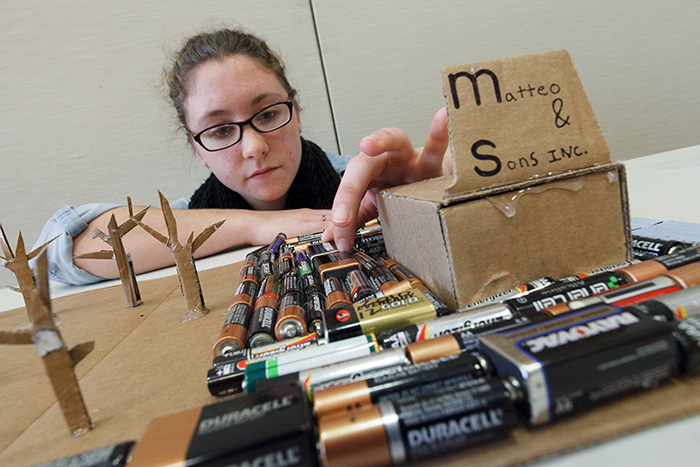Sustainability Hits Home

Keriann Pfleger ’17 studied a contaminated landfill near her high school. To represent the toxins in the ground, she created a zero-waste display, using all recycled products. Photo by Carl Socolow '77.
Students study environmental, social and economic issues in familiar settings
by MaryAlice Bitts-Jackson
The bus ride from Manhattanite Rehana Rohman ’17’s home to her high school wasn’t overly unpleasant, but it was punctuated by an unforgettable landmark—a large industrial structure that exhaled an unpalatable smell. “I used to put my hoodie up over my nose for about a mile as we went past,” says Rohman (environmental studies), “but I never really knew what it was, or how it affected the health of people who live there.”
That changed this semester, when Rohman took Environmental and Social Justice, a course taught by Heather Bedi, assistant professor of environmental studies. For their final projects, students researched an environmental “bad” in a familiar place, and then investigated whether marginalized communities are disproportionately affected. The students emerged with a better understanding of how science, business, social science and social justice interconnect in communities they already know.
While Rohman researched the incinerator along her high-school bus route, fellow environmental-studies major Madden Bremer ’16 of Massachusetts looked into untreated sewage in the Merrimack River. Keriann Pfleger ’17 (biology) studied a contaminated landfill across from her hometown high school, and Kyra Adajian ’19 delved into brownfield sites in Bridgeport, Conn., and nearby Greenwich.
All of these “bads,” they learned, were seated in low-income areas with predominantly minority populations. Nearby higher-income, predominantly white neighborhoods were not, or not equally, affected.
The same is true of social-sustainability issues, says Kevin Rubenstein ’16 (environmental studies). While studying food deserts (areas in which it is difficult to buy affordable fresh food) in Baltimore, where he attended high school, Rubenstein found that access to fresh food and average life span are disproportionately lower in lower-income, predominantly African-American neighborhoods.
“It’s disheartening to learn that people in food deserts in Baltimore are dying an average of 10 years earlier, in part because of illnesses like cardiac disease and obesity, and it’s disheartening that I went to school nearby, and I didn’t know that one in four people in Baltimore do not have access to good, fresh food,” said Rubenstein, who arranged to give a poster detailing his findings to one of his former high-school teachers. The poster will be hung in a classroom so other Baltimore students can benefit from what Rubenstein learned.
Research like this puts a human face on business and environmental concerns, said Madeleine Jones ’19, who investigated seismic testing off the coast of Ocean City, Md., where her grandparents live. “When I think about environmental issues, I tend to focus on the effects [of pollutants and global warming] on trees and animals,” she says. “But this course really brought home to me that if we don’t have clean air and water, we also don’t have a healthy [human] population.”
For Anna Murdoch ’18 (sociology), whose work focused on the lower St. John’s River Basin (St. John’s County, Fla.), the course likewise added new dimensions to social-justice issues. Anastasia Khlopina ’18 (international business & management) pointed out that sustainability and social justice are important considerations in her field too. A Russian native, Khlopina looked at environmental waste in Birmingham, Ala., where she studied as a high-school foreign-exchange student.
“When I first visited Birmingham, I fell in love with the beautiful skyscrapers and skyline,” she says. “But now I realize that what we as privileged people see when we look at the city is very different from what people who live in the center of the city see and experience every day. And I’m interested in learning how corporations are able to not just make a profit, but also help improve people’s lives.”
Daniela Aldrich ’19, a Carlisle native, agrees. “My eyes have been opened to so many issues in this class,” says Aldrich, who researched an incinerator in center-city Harrisburg, Pa., and found the work so engrossing that she enrolled in a related course, Environment and Society, for the spring. “I learned that sustainability occurs where environmental, social and economic interests all convene.”
Learn more
- Department of Environmental Studies & Environmental Science
- Sustainability at Dickinson
- Liberal Arts
- Latest News
Published December 18, 2015